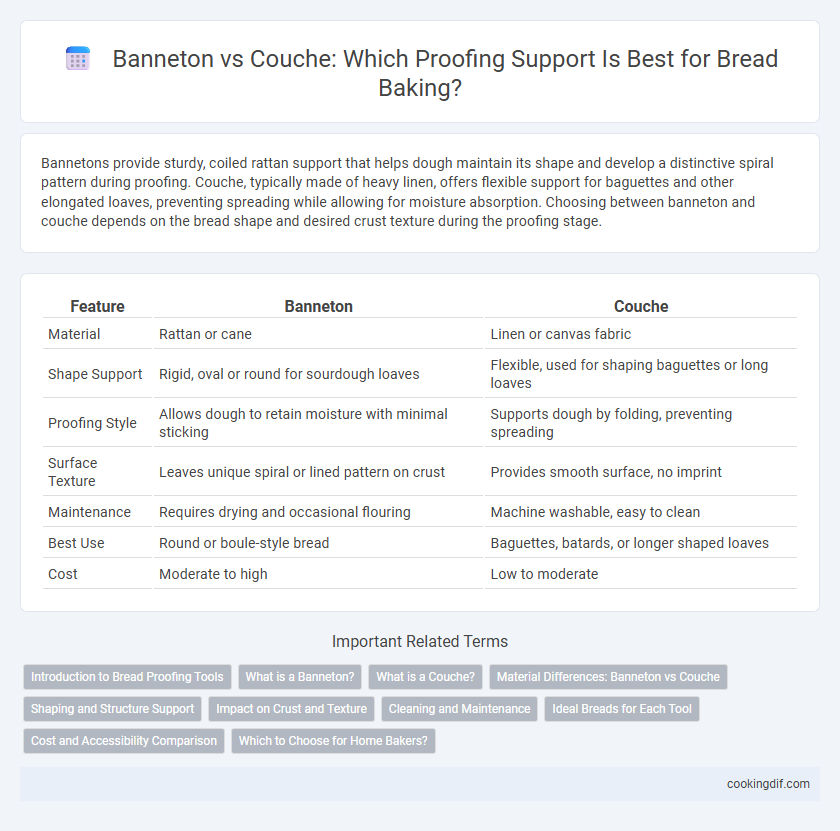Bannetons provide sturdy, coiled rattan support that helps dough maintain its shape and develop a distinctive spiral pattern during proofing. Couche, typically made of heavy linen, offers flexible support for baguettes and other elongated loaves, preventing spreading while allowing for moisture absorption. Choosing between banneton and couche depends on the bread shape and desired crust texture during the proofing stage.
Table of Comparison
| Feature | Banneton | Couche |
|---|---|---|
| Material | Rattan or cane | Linen or canvas fabric |
| Shape Support | Rigid, oval or round for sourdough loaves | Flexible, used for shaping baguettes or long loaves |
| Proofing Style | Allows dough to retain moisture with minimal sticking | Supports dough by folding, preventing spreading |
| Surface Texture | Leaves unique spiral or lined pattern on crust | Provides smooth surface, no imprint |
| Maintenance | Requires drying and occasional flouring | Machine washable, easy to clean |
| Best Use | Round or boule-style bread | Baguettes, batards, or longer shaped loaves |
| Cost | Moderate to high | Low to moderate |
Introduction to Bread Proofing Tools
Bannetons, made from natural rattan, provide structured support and moisture-wicking properties that help dough maintain shape during proofing, producing defined crust patterns. Couches, typically made from linen, offer a flexible and breathable surface that prevents sticking and allows for gentle spreading of wetter doughs during the final rise. Both tools enhance dough handling but are chosen based on dough hydration levels and desired crust texture in artisan bread baking.
What is a Banneton?
A banneton, also known as a proofing basket, is a coiled cane or rattan basket used by bakers to support the dough during its final rise, helping to maintain shape and create distinctive patterns. It absorbs moisture from the dough surface, which aids in forming a crispy crust while preventing sticking. Compared to a couche, which is a linen cloth used for proofing, a banneton offers rigid support and can create aesthetically pleasing spiral imprints on the bread crust.
What is a Couche?
A couche is a heavy linen or canvas cloth used in bread baking to support dough during proofing, particularly for baguettes and other elongated shapes. Its textured surface absorbs excess moisture, preventing dough from sticking while maintaining proper hydration and allowing for gentle fermentation. Compared to bannetons, which are rigid baskets that shape round loaves, couches offer flexible support that accommodates varied dough shapes and sizes.
Material Differences: Banneton vs Couche
Bannetons are typically made from natural rattan or cane, providing a rigid, breathable structure that helps dough maintain its shape and develop a patterned crust during proofing. In contrast, couches are usually crafted from linen or canvas fabric, offering a softer but supportive surface that prevents sticking through flour dusting while encouraging a smooth, round loaf. The material differences between bannetons and couches influence airflow and moisture retention, which directly affect crust texture and dough rise quality.
Shaping and Structure Support
Bannetons provide firm, coiled rattan support that helps dough maintain its shape and develop a defined structure during proofing, especially for wet or sticky doughs. Couche, made from heavy linen, offers gentle support by creating textured folds that prevent dough from spreading, enhancing surface tension and shaping precision. Both tools improve proofing results, but bannetons are preferred for added rigidity, while couches excel in accommodating delicate or high-hydration doughs.
Impact on Crust and Texture
A banneton promotes a thicker, crispier crust by providing structured support and moisture-wicking properties that shape the dough while allowing airflow. In contrast, a couche preserves a softer crust and a more open, airy crumb by gently supporting dough with linen folds that minimize surface dryness. Choosing between banneton and couche impacts the final bread's crust thickness and texture, tailoring results to artisan preferences.
Cleaning and Maintenance
Bannetons require thorough cleaning with a stiff brush and occasional baking to remove dough residues and prevent mold, ensuring hygienic use and extending their lifespan. Couchers, typically made of linen, demand regular washing and careful drying to avoid mildew and maintain odor-free conditions. Proper maintenance of both proofing tools significantly improves dough support and final bread texture.
Ideal Breads for Each Tool
Bannetons, made from natural cane or wicker, are ideal for high-hydration doughs like sourdough and rye, offering superior moisture retention and distinctive spiral patterns for artisan loaves. Couches, typically linen or canvas, excel with baguettes and other elongated breads by providing gentle support without imprinting texture, allowing for optimal oven spring and shape during proofing. Choosing between banneton and couche depends on the bread's hydration and shape, ensuring proper structure and crust quality for every loaf.
Cost and Accessibility Comparison
Bannetons, typically made from natural rattan, are an affordable and widely available option for proofing bread dough, ranging from $10 to $30 depending on size and quality. Couche, usually linen cloths, offer a reusable and cost-effective alternative often priced under $20, with broad accessibility through online retailers and baking supply stores. While bannetons provide a firm structure that helps maintain dough shape and create characteristic patterns, couches offer flexible support ideal for baguettes and other free-form loaves, making both accessible choices depending on specific proofing needs and budget.
Which to Choose for Home Bakers?
Banneton baskets provide structured support and create distinct spiral patterns on dough, ideal for artisan-style sourdough breads, while couche linens offer flexible, breathable surfaces perfect for maintaining dough shape without imprint patterns. Home bakers choosing between banneton and couche should consider the desired crust texture and aesthetic, with bannetons enhancing crust crispiness and couches promoting a softer crust. For versatility and easy maintenance, bannetons are preferred for beginners seeking consistent rise and presentation, whereas couches are favored by those handling wetter or more delicate doughs.
Banneton vs Couche for proofing support Infographic

 cookingdif.com
cookingdif.com